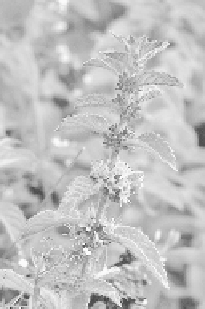Environmental Engineering Reference
In-Depth Information
Common name: Acrid weed, tooth cup
Distribution: United States
Habitat: Swampy and damp sites
Description: It is an erect, branched, smooth, slender, annual purplish herb
growing to a maximum height of 50 cm with four-angled stems. Leaves are
narrow-oblong, oblance shaped with 4 cm length each. Flowers are small,
1 mm long, greenish or purple, and borne in dense clusters in the leaf axis.
Compounds and activities: The ethanol extract of this species possesses an
antisteroidogenic property. At doses of 100, 200, and 400 mg/kg body
weight, this extract was found to arrest the normal estrus cycle at dioestrus
phase and signiicantly reduced the weight of ovaries. The extract also sig-
niicantly inhibited the activity of Δ5-3β-hydroxyl steroid dehydrogenase
(Δ5-3β-HSD) and glucose-6-phosphate dehydrogenase (G-6-PD) enzymes
involved in ovarian steroidogenesis (Dhanapal et al., 2005). Leaves or ashes
of plant mixed with oil are applied to cure herpetic eruptions, and fresh
leaves are used for treating skin diseases.
MENTHA ARVENSIS
LINNAEUS
Phylum: Magnoliophyta Class: Magnoliopsida
Order: Lamiales Family: Lamiaceae
Common name: Field mint, wild mint, corn mint
Distribution: Europe, Asia, Siberia, North America
Habitat: Wet grasslands near rivers and lakes
Description: It is a perennial herbaceous plant growing to a maximum height
of 1 m. Leaves (7 × 2 cm) are simple and are in opposite pairs. They are
hairy with coarsely serrated margins. Flowers (4 mm long) are purple, pink,
or white and are present as clusters on the stem.
Compounds and activities: The extracts of this species showed highly signii-
cant activity against gastric ulcers. A decrease in gastric secretion and ulcer
index was recorded among the treated groups, i.e., petroleum ether (53.4%),
chloroform (59.2%), aqueous (67.0%), and in standard drug (68.7%), when
compared to the negative control (Londonkar and Poddar, 2009).

